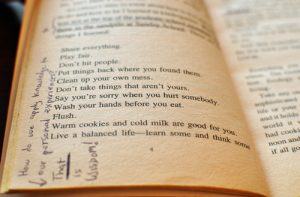Davidson on Marginalia and Authors as Readers

“I suggest strategies by which texts may be deciphered in terms of the complex set of generic, stylistic, thematic, cultural, ideological, and literary expectations that readers bring to texts and that authors (themselves readers of the work that they are writing) play with and around in the creation of texts” (Davidson 60).
“In extant copies of the novels and in other kinds of books as well, readers have often left their marks . Inscriptions and marginalia tell us something about how books were valued and how they were read” (Davidson 62).
Davidson’s argument about the usefulness of a reader’s marginalia can be connected to the impact of Williams’s footnotes throughout Fall River. Because authors are “themselves readers of the work they are writing,” Williams’s footnotes provide insight into the thoughts and cultural influences that went into her writing.
Examples from Fall River
“Who can wonder that infidels should be strengthened by such things as these? What a farce does even Christian worship appear when prostituted to secular purposes” (Williams 40).
“What mighty despotism, what scheme of bondage, what film of ignorance and fanaticism, what system of ecclesiastical tyranny, may not the death of this woman be intended to break?” (Williams 45).
These footnotes are examples of moments in the text where Williams felt compelled to break from the narrative to insert her own thoughts about the story. These annotations on her own story provide us with useful information about the beliefs and emotions that influenced the author in her writing.
